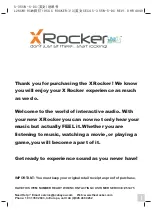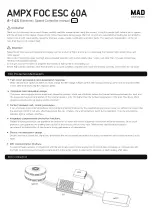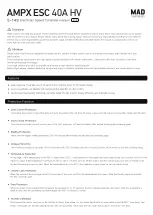
5
www.enersys-emea.com
• the terminals, connecting straps and fasteners are adequately
coated with lanolised petroleum jelly.
Front covers have slots located in each corner. Use the screws
supplied to fasten the covers onto the captive nuts located in the
front face of the stand frames.
8. Commissioning Charge
It is recommended that chargers are of the constant voltage
type. The output characteristic should give an applied charge
voltage of 2.28±0.01Vpc (at 20°C) or temperature compensated
equivalent (see section 9.2.1) with a minimum output current
expressed numerically in amperes as 10% of the 10 hour
capacity rating of the battery.
The commissioning charge should be carried out, without any
other load being connected to the charger, as follows:
• connect charger positive output to battery positive terminal,
charger negative output to battery negative terminal.
• switch on and charge continuously until the current flow into
the battery has fallen to a minimum and stabilised to remain
relatively constant over 3 consecutive hourly readings.
If it is not possible to determine the current, the battery may be
assumed to be fully charged after a minimum continuous charge
period of 6 days.
The battery temperature should be monitored during the
commissioning charge. If it exceeds 40°C the charge must be
terminated immediately; it should not be continued until the
temperature has fallen to 32°C.
NB: If the battery is to be subjected to a site acceptance test
before going into service, this must be carried out in the period
between completion of the commissioning charge and the
introduction of operating load on the system.
On completion of the commissioning charge (and, if required,
site acceptance test and subsequent recharge) the load circuit
can be introduced on to the system and the battery maintained
in the normal float charge mode.
9. Operation
9.1 Chargers
Constant voltage chargers only are recommended for normal
continuous operation.
9.2 Charging
9.2.1 Applied voltage level for normal float charge
For all normal operating conditions, and particularly where the
battery is maintained fully charged continuously in parallel with
the charger and load circuit, it is recommended that a voltage
level equivalent to 2.28±0.01Vpc (at 20°C) is applied to the
battery terminals.
Where the mean operating temperature is not 20°C, the applied
voltage level should be adjusted as follows:
• 2.28Vpc + 0.003V per cell per °C below 20°C
• 2.28Vpc - 0.003V per cell per °C above 20°C
To prevent the possibility of undercharge, it is important that the
applied charge voltage does not drop below the minimum
recommended value for the operating temperature.
Similarly, to prevent the possibility of overcharge, any excursion
of 'battery voltage' above the maximum recommended value for
more than one minute should either be alarmed or cause
immediate termination of the charge (except under controlled
elevated voltage conditions described in section 9.2.2).
This level of applied voltage is recommended for both the
Refresher Charge (section 6) and Commissioning Charge (section
8) procedures or to recharge the battery following a discharge.
Under these conditions, it will typically require a period of
continuous charge in excess of 72 hours to fully recharge a battery
which has previously been discharged to the extent of its 10 hour
capacity. The battery will be fully recharged when the charge
current has reduced to a very low value and has remained
reasonably constant for 3 consecutive hourly readings.
At 2.28±0.01Vpc (at 20°C), this value of end of charge current
will typically be in the region of 0.5mA per Ah of the rated 10 hour
capacity.
9.2.2 Applied voltage level for faster recharge
Recharge time can be reduced by increasing the level of applied
charge voltage.
If the time available for recharge is constrained, then the battery
may be recharged by applying a maximum constant voltage level
of 2.35 Volts per cell. However, using this charging regime:
• will result in a reduced service life if used more than once per
month.
• requires the charge current to be limited to a value expressed
numerically in Amperes to 10% of the 10 hour capacity rating of
the battery (e.g. 85 Amps for battery of DDm 85-21).
• requires the charge to be terminated when the charge current
stabilises; typically this will be in the region of 3mA per Ah of the
rated 10 hour capacity rating of the battery.
If necessary, the Refresher Charge procedure (section 6) may be
carried out using this elevated voltage level; however, the charge
must be terminated after a maximum continuous charge period of
8 hours. Similarly, the Commissioning Charge procedure (section
8) may be carried out using 2.35 Volts per cell for a maximum
continuous charge period of 12 hours.
However, neither of these 2 alternative procedures should be
attempted without first referring to EnerSys
®
for precise
instructions.
9.2.3 Equalising charge
Under normal conditions an equalising charge is not required.
However, in some circumstances, a maximum continuous charge
period of 12 hours using 2.35 Volts per cell or an extended period
of carefully controlled low value constant current charge may
prove beneficial.
EnerSys must be contacted for advice if an equalising charge is to
be undertaken.
9.2.4 Charge current
For optimum charge efficiency, the recommended charge current
to the battery should be a value expressed numerically in
Amperes equivalent to 10% of the 10 hour capacity rating of the
battery.
However, PowerSafe
®
DDm batteries will accept higher values of
charge current without damage providing that the applied charge
voltage does not exceed the normal float charge voltage level of
2.28±0.01Vpc (at 20°C) or temperature compensated equivalent
(see section 9.2.1).
It is important that the 10% C
10
Amperes current becomes a
maximum value when applying any value of elevated voltage
between 2.29 Volts per cell and 2.35 Volts per cell.
Summary of Contents for PowerSafe 2DDM50-09
Page 11: ...11 www enersys emea com Notes...






























